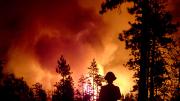Lightning, topography, and human-related activities start a large number of wildfires every year, but during the next 40 years it is climate change that will lead to a major increase in such blazes in the American West, according to a new Harvard School of Engineering and Applied Sciences (SEAS) study. The study will appear in the October 2013 issue of Atmospheric Environment.
“It turns out that, for the western United States, the biggest driver for fires in the future is temperature, and that result appears robust across models," says Loretta J. Mickley, a senior research fellow in atmospheric chemistry at SEAS and coauthor of the study. “When you get a large temperature increase over time, as we are seeing, and little change in rainfall, fires will increase in size.”
Although wildfires are triggered primarily by human activity and lightning, they grow and spread according to a completely different range of influences that are heavily dependent on the weather, says study lead author Xu Yue. By examining records of past weather conditions and wildfires, the Harvard team found that the factors which influence the spread of fires vary from region to region, ranging from the amount of moisture in the forest floor to the relative humidity of the previous year, which promotes the woody understory shrub growth that fuels major wildfires.
The team then created mathematical models that closely link these types of variables with the observed wildfire outcomes for six “ecoregions” in the West, before replacing the historical observations with data based on the conclusions of the fourth Intergovernmental Panel on Climate Change (IPCC). By running the IPCC's climate data for the year 2050 through their own fire-prediction models, the Harvard team was able to calculate the area burned for each ecoregion at mid century.
“I think what people need to realize is that, embedded in those curves showing the tiny temperature increases year after year, are more extreme events that can be quite serious,” Mickley says. “It doesn't bode well.”








